Norwegian interests get involved offshore

Initial interest
Paul Endacott, chief executive of America’s Phillips Petroleum Company, was on holiday in Europe during the summer of 1960. While visiting the Groningen area of the Netherlands, he was interested to see a drilling rig standing in shallow water.
He did not know what this was looking for, but had heard of the big gas discovery in the area. He also knew that shallow oil had been found in eastern England.
Endacott speculated that the whole North Sea area was a big sedimentary basin of great geological interest and, on his return to the USA, asked the Phillips board to consider opportunities for oil exploration in these waters.[REMOVE]Fotnote: Phillips Historical Project, video interview with Paul Endacott.
 Norske interesser inn i oljevirksomheten,
Norske interesser inn i oljevirksomheten,That unleashed hectic activity in the company. All the oil journals were trawled. BP, Esso and Shell were already conducting seismic surveys in the southern North Sea. Like them, Phillips believed the area off the West German and Dutch coasts to be the most interesting in geological terms. West of Denmark followed, then the waters off eastern England.
Based in Paris and headed by Ward Dunn, the international exploration arm of Phillips was given the job in 1962 of collecting further geological information and applying to the respective national governments for licences.[REMOVE]Fotnote: Letter from H D Brookby to Mr Paul J Parker, dated 14 August 1962. Subject: North Sea Basin – England, Netherlands, West Germany and Denmark. Reply Paul Endacott’s August 8, 1962 Memo. But the question was whether the sedimentary source rocks for oil and gas in the North Sea basin stretched further north than first assumed.
If the median line principle was followed in dividing up the continental shelf in the North Sea, Norway and the UK would receive the biggest shares.
Competition for licences in Germany would be stiff, while Denmark had already awarded a 50-year licence to the A P Møller group for the whole country – including its continental shelf. In the UK, all the companies would be on an equal footing in the first licensing round.
Norway was the only country which had not previously been contacted by any oil company, and Phillips decided to do this. At the recommendation of the Norwegian embassy in Bonn, the company got in touch with former UN secretary-general Trygve Lie.
Lie asked for a written proposal which could be considered by the Industrial Financing Commission he chaired on 1 November. Dated 29 October 1962, the letter from Phillips states:
“We have reasons for believing that the geological basin in which large reserves of natural gas have been discovered in Holland may be extended northward into the Norwegian portion of the North Sea. Therefore, Phillips Petroleum Company is interested in obtaining from the Norwegian Government an oil and gas concession covering the lands lying beneath the territorial waters of Norway plus that portion of the continental shelf lying beneath the North Sea which may now or in the future belong to be under the jurisdiction of Norway. In return for such concession, Phillips would obligate itself to conduct a reconnaissance seismic survey of that area of the North Sea which might come under Norwegian jurisdiction.”[REMOVE]Fotnote: Stig S Kvendseth (1988), Giant Discovery. A History of Ekofisk Through the First 20 Years, 10-11.
Phillips undertook that such survey work would be worth USD 1 million. Lie acknowledged the letter on 5 November, and said it had been passed to the Ministry of Industry for further consideration. There it remained for the time being.
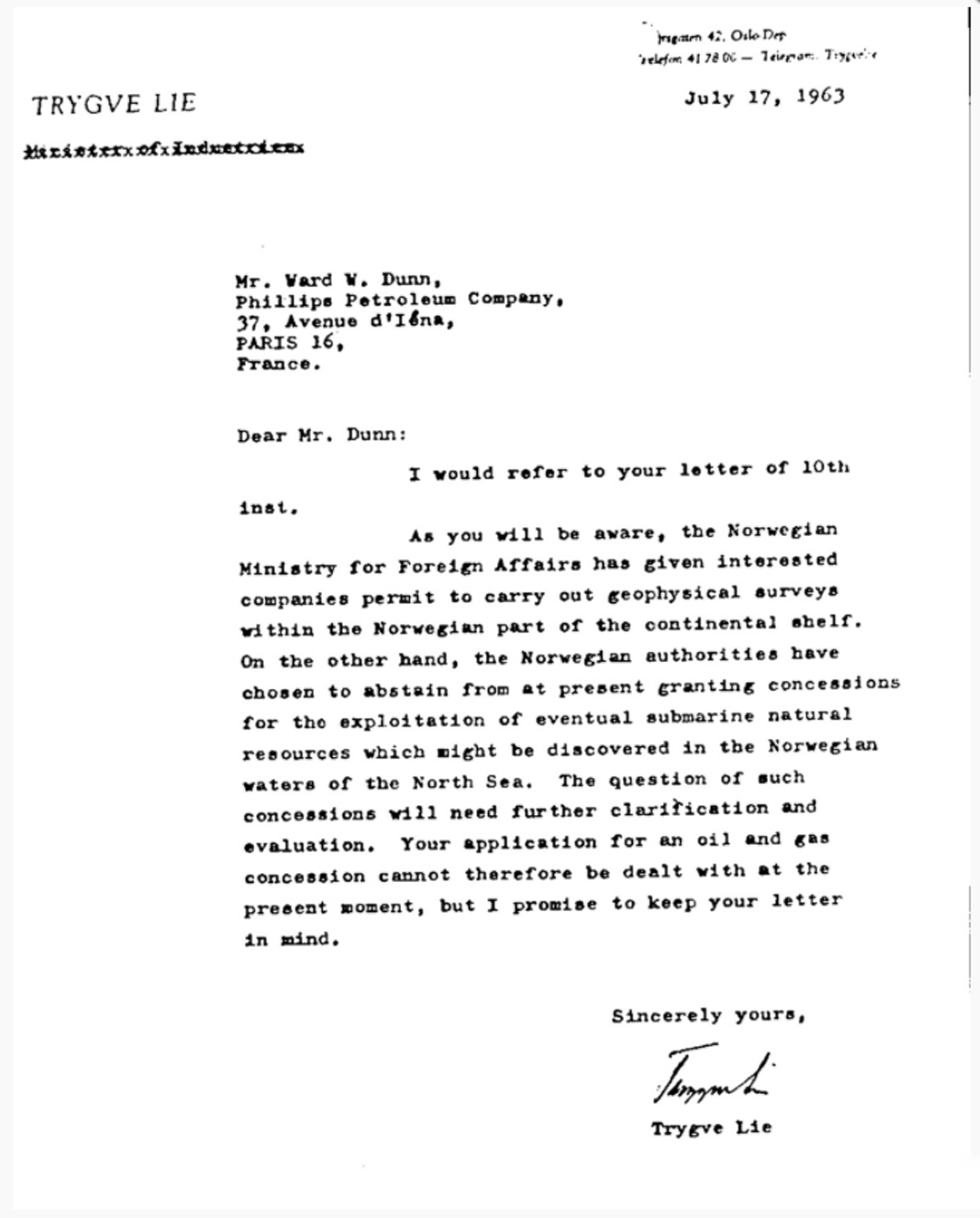 Norske interesser inn i oljevirksomheten
Norske interesser inn i oljevirksomhetenAn awareness began to dawn in Norway that North Sea resources might extend beyond fish. Hans Holtedal, a geologist at the University of Bergen, contributed an article to Oslo daily Aftenposten on 11 May 1963 under the heading “Oil on the Norwegian continental shelf?”.
He argued that the government must start to interest itself in the shallow sea areas off the coast. Although these lay beyond the three-mile territorial waters and the 12-mile fishing limit, they belonged to Norway. National rights along the coast needed to be secured as quickly as possible.[REMOVE]Fotnote: Aftenposten , 11 May 1963, “Olje på den norske kontinentalsokkel?”.
The government was working on the matter, and declared Norwegian sovereignty over the continental shelf in a royal decree issued on 31 May 1963.
This declaration needed to be supplemented by legislation to regulate exploration for and utilisation of possible natural resources, and a provisional Act was passed on 21 June 1963.
That laid the basis for preparatory prospecting on the Norwegian continental shelf (NCS), with a total of 10 permits issued in 1963 – all to foreign companies.[REMOVE]Fotnote: Schartum, Dag (1990), Hvordan Noco ble til…, 7.
Seismic survey ships and aircraft equipped for geomagnetic surveying were in full swing on the NCS from the summer of that year.
Canadian initiative
Just as it took Phillips knocking on the door to galvanise the Norwegian government, a Canadian initiative was required to arouse interest in oil exploration among Norwegian industrialists.
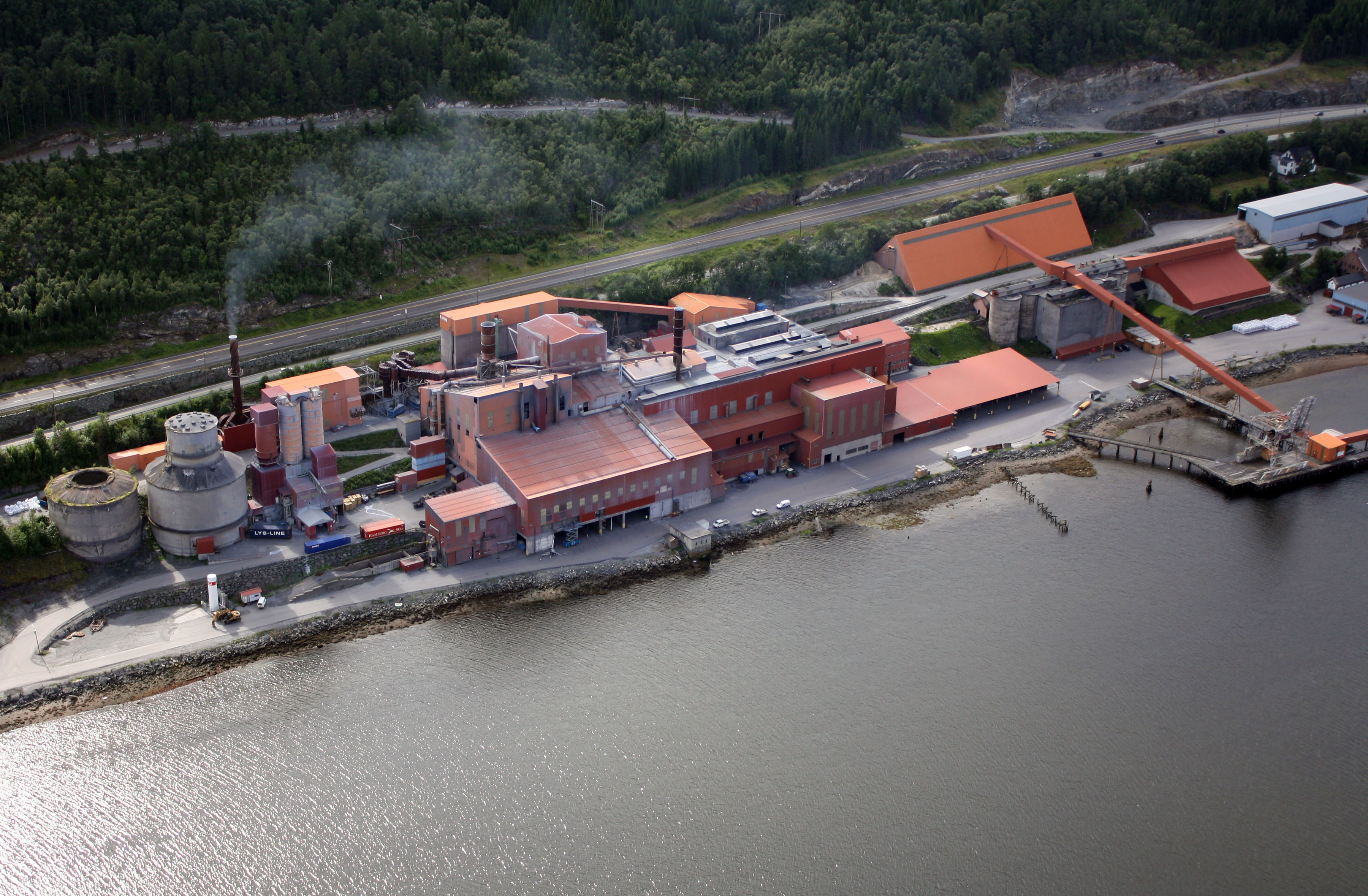 Norske interesser inn i oljevirksomheten
Norske interesser inn i oljevirksomhetenRobert (Bob) O Svare wrote on 10 October 1963 to Georg Hagerup-Larssen, chief executive of Elektrokemisk A/S. Born in Canada to Norwegian parents, Svare was the owner of Calgary-based Well Information Service Ltd and had many years of oil experience.
This had given him detailed knowledge not only of petroleum activities in Canada, but also about geological indications and exploration activity around the world.
With his Norwegian background, Svare learnt with interest of the opportunities opening up in the North Sea. He had met Hagerup-Larssen before and, since Elektrokemisk was a big consumer of hydropower, assumed that the company would also be concerned about energy sources like oil and gas.
Svare wrote that the biggest and most interesting oil industry activity in the world at that time was taking place in the North Sea, and had a fantastic potential.
Should oil and gas be found in only 30-40 metres of water, drilling for and producing gas for a big west European market would not be difficult. He wrote:
“I believe it is very essential at this time for Norwegian industry to seriously and carefully consider active participation in these opportunities. It is my opinion that an industry so vital for any country exclusively controlled by foreign interests is not in the national interest of Norway, nor is it in the best interest of Norwegian business.”[REMOVE]Fotnote: Bob Svare’s letter on “Oil prospects in the North Sea”, March 1964.
Svare’s plan was to establish Norsk Exploration Limited (NEL), a domestic company with Norwegian management owned 80 per cent by companies in Norway and 20 per cent by his own firm.
He believed that NEL should work to persuade the government to declare sovereignty over the Norwegian part of the North Sea and to require any foreign oil company licensed to explore for oil to give a 20 per cent interest to a domestic partner. The latter could by all means be NEL, if it was strong enough.[REMOVE]Fotnote: Schartum, Dag (1990), Hvordan Noco ble til…, 8-9.
This story is known in detail because Dag Schartum, Hagerup-Larssen’s close collaborator on the oil issue, collected relevant documents around 1990 and wrote a history of Noco’s creation ( Hvordan Noco ble til… ). That provides an insight into the strategy and thinking on oil in the industry’s earliest phase in Norway.
Svare’s approach was aggressive, but the time was not quite ripe. A continental shelf committee chaired by division head Jens Evensen in the Ministry of Industry was first established on 8 November 1963.
In Hagerup-Larssen’s view, this body had to acquaint itself with the subject matter before it could begin to draw up political guidelines.
Svare insisted in a letter to the Elektrokemisk chief on 14 January 1964 that swift action must be taken or he would contact others who might be interested.
The two agreed to meet in New York a few days later, when Hagerup-Larssen became convinced by Svare’s enthusiasm that Norwegian companies should participate in North Sea exploration.
Before going any further, however, he had to consult his chairman, Nils Astrup from Fearnley & Astrup. The latter agreed it would be wrong for Norwegian industrial companies and shipowners to be excluded from what was starting to happen in the North Sea.
Hagerup-Larssen secured a meeting with Evensen on 4 February 1964, which confirmed that the government would be positive if Norwegian companies became involved in offshore exploration.
As an amusing aside, it can be mentioned that the Elektrokemisk boss also told industry minister Karl Trasti about the plans to establish Noco.
“And there was I thinking you were a sensible person, Hagerup-Larssen,” Trasti is said to have cried. People did not seem to have much faith in finding oil on the NCS.[REMOVE]Fotnote: Schartum, Dag (1990), Hvordan Noco ble til…, 89.
The question was who would join a Norwegian venture. Hagerup-Larssen and Astrup turned primarily to people and companies they knew, and it transpired that some of these had already been contacted by other oil companies.
Shipowner Sigvald Bergesen Jr had been approached by Belgium’s Petrofina and Phillips, for example, to ask whether he could take the lead in establishing a Norwegian group.
Bergesen had not made much progress with this, but had contacted paper manufacturer Borregaard A/S – and Hagerup-Larssen. He quickly became a useful ally, and indicated that he could contemplate taking part to the tune of “a few hundred thousand dollars”.[REMOVE]Fotnote: Schartum, Dag (1990), Hvordan Noco ble til…, 10-11.
On one occasion, the tanker operator told Hagerup-Larssen: “To be totally honest, I haven’t a clue what this is about, but if you want to take part, Georg, so do I.”[REMOVE]Fotnote: Schartum, Dag (1990), Hvordan Noco ble til…, 81.
The statutory general meeting for the Noco limited partnership was held on 5 March 1964, when a draft prospectus was presented. Nine of Norway’s largest industrial and shipping companies formed the founding partners.
These were Christiania Spigerverk, Sig Bergesen d.y & Co, Kværner Brug A/S, Borregaard, Akers mek Verksted A/S, Anders Jahre and Orkla Grube-Aktiebolag, as well as Elektrokemisk A/S and Fearnley & Astrup. Svare’s Europetrol company was also involved to carry out the technical work.[REMOVE]Fotnote: Prospectus of the Norwegian Oil Consortium dated 5 March 1964.
Via Martin Siem, chief executive of Aker, Astrup was asked whether shipping company Fred Olsen & Co could also become one of the partners. That was refused on this occasion.
Olsen has subsequently claimed he was turned down by Astrup, and took this to mean that the latter – who had a dominant role in four of the Noco partners – wanted to keep control to himself.[REMOVE]Fotnote: Fred Olsen in an interview with Sigvart Østrem, NRK, 8 June 2009.
During this phase, Svare and his partners were very active in seeking to secure the best possible position for the consortium. Canadian lawyer Miles Patterson, a former adviser to the Energy Board of Canada and participant in framing Canadian oil and gas law, handled the necessary contractual work.
Svare’s strategy was for Noco to apply on its own account for licences to explore for petroleum. Once these were secured, it would negotiate collaboration deals with international oil companies.
A royal decree of 15 May 1964 authorised Noco to conduct seismic surveys. Existing aerial geomagnetic data provided the basis for shooting about 1 000 kilometres of marine seismic lines by Germany’s Prakla in the North Sea for Noco during 1964.
Europetrol’s geologist was Dr Rudolph Martin, who had retired after 25 years with Royal Dutch Shell and Shell of Canada. He concluded on 24 August:
“The information gathered to date indicates that hydro-carbons do almost certainly occur in the North Sea off Norway, and there are number of structures which may have led to the accumulation of such hydrocarbons. This information … is not sufficient, however, for an exploration programme. After concessions are obtained, detail seismic work is therefore necessary, to be followed by drilling.”[REMOVE]Fotnote: Schartum, Dag (1990), Hvordan Noco ble til…, 14-15.
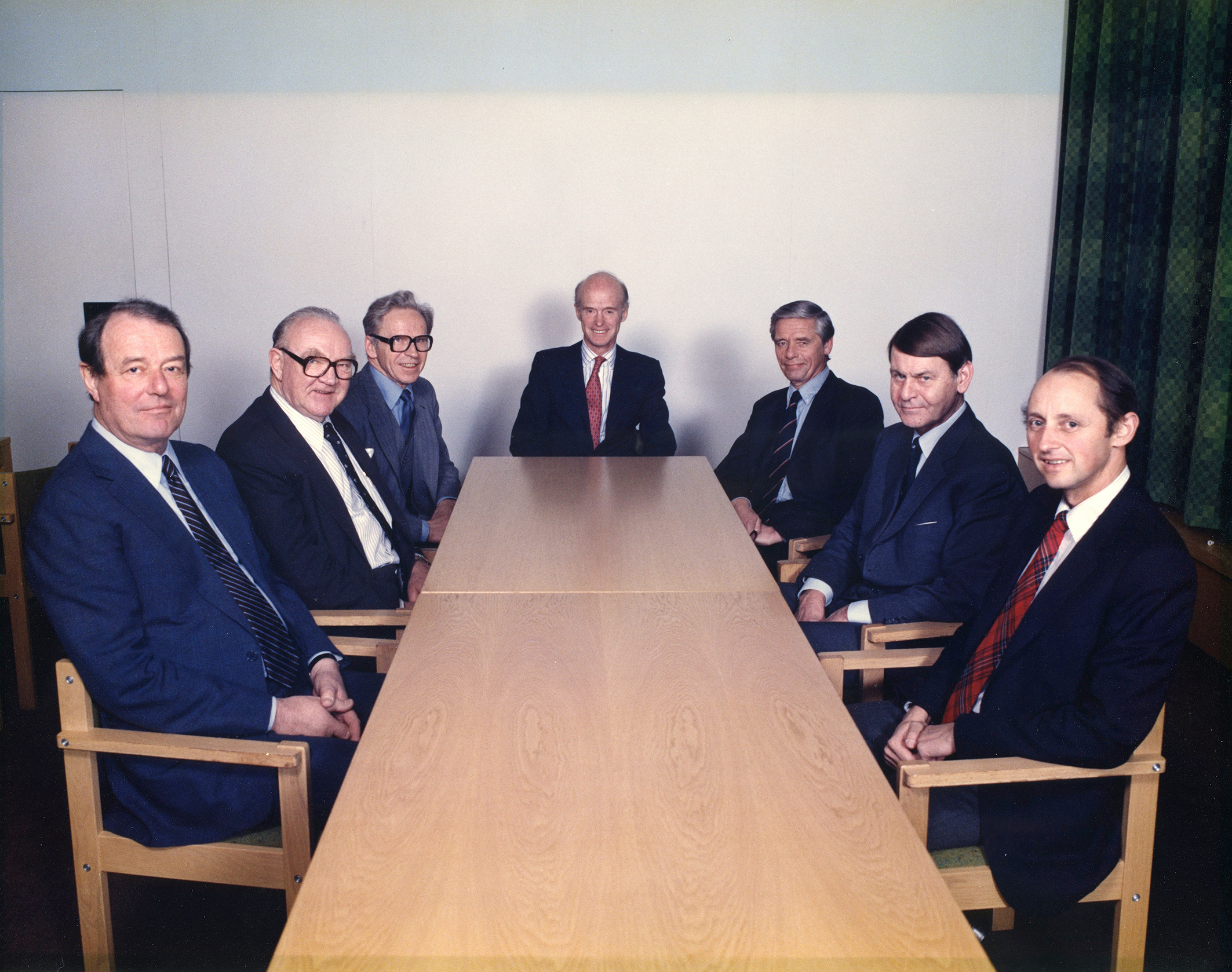 historie, Norske interesser inn i oljevirksomheten
historie, Norske interesser inn i oljevirksomhetenNoco’s partners expected at this stage to be able to negotiate with one or more international oil companies on a collaboration. A number of the latter got in touch, but their approaches were put on hold until the government’s licence terms had been clarified.
Another question posed by the Canadians was whether the Norwegian companies intended to exploit the commercial opportunities offered by the petroleum sector.
Europetrol proposed the creation of Norwegian companies for drilling, supplying equipment to North Sea oil operations, and providing supply ship and helicopter services.[REMOVE]Fotnote: Schartum’s archive at the Norwegian Petroleum Museum, Bob Svare’s memorandum of 25 June 1964, “Drilling and Supply companies”.
Although these were good ideas, most of the Norwegian partners had enough to do at the time in helping to establish an oil company. Only three of them – Akers Mek Verksted A/S, Sig Bergesen d.y & Co and A/S Kværner Brug – were interested in participating in supply activities.[REMOVE]Fotnote: Schartum, Dag (1990), Hvordan Noco ble til…, 23.
Questions of collaboration
A tug-of-war was waged in the consortium from day one over the strategy to be pursued on the issue of collaboration with a foreign oil company.
The Canadian interests were convinced that Noco, with 80 per cent Norwegian ownership, would be awarded the most valuable blocks on the NCS.
With these in hand, it could secure a carried-interest agreement (risk-free participation) of up to 50 per cent with an oil company.
This sounded attractive to the partners who were not interested in committing more capital. The question was whether it represented a realistic vision.
A meeting between Evensen and seven of the partners helped to clarify matters. He said that foreign oil companies who had contacted him were told that an alliance with a Norwegian group could be advantageous.
At the same time, he made it clear that a Norwegian group would also benefit from allying with one or more international partner. He emphasised that the government’s ignorance of the oil business made it essential to commit to foreign companies.
Asked directly when it would be best for the consortium to join forces with a foreign partner, Evensen replied that this ought to happen before the draft licensing Act was presented – probably during the autumn of 1964.
He took the view that the oil companies overestimated how important it would be to have Norwegian partners, because they thought the government would favour national interests.
They would discover from the draft Act being drawn up that there was not so much to be gained from securing domestic participation. So it would be wise to start negotiating with them before they changed their minds.[REMOVE]Fotnote: Schartum, Dag (1990), Hvordan Noco ble til…, 30-31.
Negotiations with foreign oil companies
Initial talks were pursued with several oil companies, starting with the firstcomers – Petrofina and Phillips Petroleum UK Ltd. Their representative, J Weekers, wrote as follows to Hagerup-Larssen on 12 March 1964:
“I would like to confirm that Petrofina and Phillips have a desire to become as much as possible integrated into the Norwegian Community. We have therefore decided to cooperate with Norwegian partners.”[REMOVE]Fotnote: Schartum’s archive at the Norwegian Petroleum Museum, Letter to Hagerup-Larssen from J Weekers, 12 March 1964.
Noco had just been established, and had to ask for time to respond. The same applied to approaches from American Overseas Petroleum Ltd (Amoseas) in the Hague, Superior Oil International Inc (Caltex group) from Texas, and Kerr-McGee Oil Industries Inc of Oklahoma.
Negotiations eventually got under way, with the emphasis on whether the oil company concerned was able to offer a carried-interest deal – preferably up to 50 per cent until a discovery was made.
If commercially recoverable petroleum was found, Noco would continue to participate and pay its share of the costs. But it would not contribute to expenditures if no discoveries were made.
Petrofina and Phillips stood out as the companies which Noco most wanted to collaborate with. The chemistry during the negotiations was good, but the drawback was that the oil companies wanted the consortium to be an equal partner.
It would have an interest of up to 20 per cent, without any form of special advantages – “no oil company was willing to pay extra for a partnership in order to secure the participation of national interests.”[REMOVE]Fotnote: Schartum’s archive at the Norwegian Petroleum Museum, Minutes of the meeting of 25 July 1964 with J Weekers and C Campbell.
A more pragmatic attitude prevailed in the meeting with Amoseas on giving the Norwegian consortium a carried interest of five to 15 per cent.
However, the company was sceptical about becoming involved on the NCS before the licence terms were known, and was afraid that the government would prove greedy towards the oil players.
The meeting with Superior Oil encouraged the consortium’s desire for a carried interest of up to 25 per cent. When the written offer was presented, however, it proposed Norwegian participation of 20-40 per cent, full equality and no carried interest.[REMOVE]Fotnote: Schartum, Dag (1990), Hvordan Noco ble til…, 35-36.
No meeting was held with Kerr-McGee Oil Industries at this stage. Instead, another company turned up – American International Oil Company (Amoco), the production arm of Standard Oil of Indiana.
It had not started seismic surveying in the Norwegian North Sea, and was interested in collaborating on such studies and on a joint licence application.
Amoco was readier than the other companies to offer an equal or almost equal Norwegian participation of 40-50 per cent. It was also prepared to discuss carried interest.[REMOVE]Fotnote: Schartum’s archive at the Norwegian Petroleum Museum, Minutes of meeting of 7 August 1964 with Walter MacDonald, American International Oil Company.
This was the best offer received up to the autumn of 1964. But the initial talks had shown that the requirement for a 50 per cent carried interest was unusual and met little understanding among the oil companies. Noco accordingly had to lower its sights.
Olsen establishes Noco II
The formation of several Norwegian groups keen to become involved in oil exploration was in the air during the summer of 1964. Hydro had already joined force with France’s BRP, RAP and Compagnie Francaise des Petroles (CFP) to acquire 20 per cent of the Hydronord group.
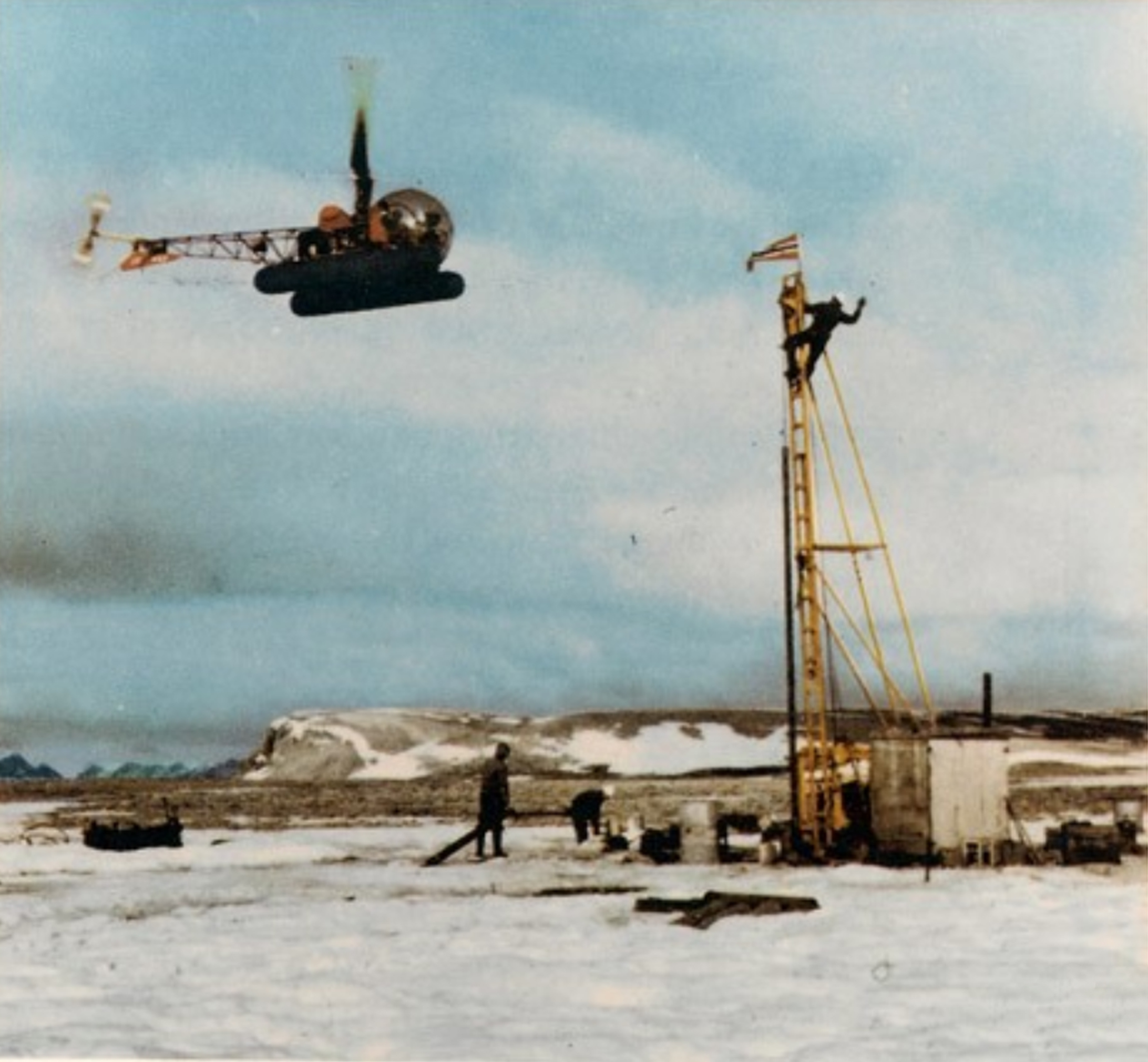 Norske interesser inn i oljevirksomheten,
Norske interesser inn i oljevirksomheten,Olsen, who had big interests in Noco partner Akers mek Verksted, was also interested in the oil sector. Among other moves, Aker had acquired a licence covering acreage on land in Svalbard to prospect for petroleum there.
This Arctic archipelago was the subject of unusually intense scientific and not least geological interest at the time, although it failed to yield commercial results.
As the owner of cargo liners and tankers, Olsen was accustomed to identifying and interpreting global trends. In his role as an international industrialist, too, he saw opportunities for new economic activity at a time when many believed oil could not be found beneath the North Sea.[REMOVE]Fotnote: Leif Dons in a Festschrift to Fred Olsen on his 70th birthday.
Among other moves, he had visited Houston – centre of the world’s offshore sector – to learn about the oil industry and had met many positive Americans there.[REMOVE]Fotnote: Fred Olsen in an interview with Sigvart Østrem, NRK, 8 June 2009.
Although Olsen had initially been turned down for participation in Noco, he did not allow this to put him off. He discussed the issue with a number of interests, and attracted support from Storebrand, Vesta, R S Platou A/S, Westfal-Larsen & Co A/S, J Ludwig Mowinkels Rederi A/S, A/S Union, A/S Follum Fabrikker and shipowner Einar Rasmussen.
Olsen contacted Astrup and Hagerup-Larssen in September 1964 and presented his proposed project. They agreed there was room for two Norwegian groups. To avoid being played off against each other by the foreign oil companies, however, they would maintain good contact and act in harmony with each other.
Norwegian Oil Consortium II was established in October 1964, and reached agreement with the original Noco to collaborate over further seismic surveys.[REMOVE]Fotnote: Schartum’s archive at the Norwegian Petroleum Museum, Memo from a meeting of Norwegian Oil Consortium II, 6 October 1964.
The two groups would also keep each other informed about their negotiations with oil companies on forming partnerships to apply for licences.
Complicated negotiations
John McCutchin, a retired executive of White Hall Canadian Oils Limited in Calgary was hired to advise Noco in its continued negotiations with the oil companies.
He was familiar with procedures and collaboration agreements between oil companies, and was able to travel around their offices in North America. His conclusion was that arousing company interest was not easy as long as carried interest was a requirement.
Rumours in Houston, New York and Calgary suggested that the oil companies, following discussions with the Norwegian government, no longer believed that a partnership with domestic interests would yield preferential treatment in licence awards.[REMOVE]Fotnote: Schartum’s archive at the Norwegian Petroleum Museum, Memo from negotiators R Karlsrud and B W Bommen, 27 November 1964.
It emerged during the negotiations which eventually took place with the various oil companies that they were very dissatisfied over the collaboration between the two groups.
Negotiating openly with one of them was difficult when the other would be kept fully informed. They ought either to operate separately or merge.[REMOVE]Fotnote: Schartum, Dag (1990), Hvordan Noco ble til …, 47.
This view was appreciated and, after discussions in February 1965, Noco and Noco II merged completely. The business was run for the time being from Elektrokemisk’s offices.[REMOVE]Fotnote: Schartum’s archive at the Norwegian Petroleum Museum, Memorandum, 17 March 1965, on the merger of Noco I and Noco II. Norwegian Oil Consortium A/S & Co then had 19 leading Norwegian companies plus Europetrol as partners:
- Akers mek Verksted A/S
- Askim Gummivarefabrikk A/S
- Fred Olsen & Co (A.S Ganger Rolf)
- Aksjeselskapet Kosmos
- A/S Ludwig Mowinkels Rederi
- Orkla Grube-Aktiebolag
- Forsikringsselskapet Vesta
- Smedvigs Tankrederi A/S
- Storebrand
- A/S Union (Union Co)
- Kværner Brug A/S
- Sig Bergesen d.y & Co
- Aktieselskapet Borregaard
- Elektrokemisk A/S
- Christiania Spigerverk
- Fearnley & Astrup
- R S Platou A/S
- K/S A/S Tadeli & Co
- Westfal-Larsen & Co A/S
Amoco took a positive view of this consolidation, and stood by its offer of carried interest up to and including the first well drilled, followed by a “working interest” of five to 15 per cent.[REMOVE]Fotnote: Schartum’s archive at the Norwegian Petroleum Museum, Letter to B W Bommen from Walter MacDonald, Amoco, 19 January 1965.
Although far below Noco’s original hopes, this was the best that could be achieved. To get a licence application ready, the goal was for the new Noco to conclude negotiations and enter into an agreement with Amoco after Easter 1965.
But things happened on the other side of the Atlantic during the Easter break. On 9 April, the same day the consortium met and agreed to accept Amoco’s office, McCutchin received a letter from Odeco-Murphy which offered a collaboration based on a carried interest of 25 per cent “until commercial production is obtained or three wells have been drilled, whichever first occurs”.
This was not entirely free of charge, because costs associated with the carried interest were to be repaid from initial production in the event of a discovery.[REMOVE]Fotnote: Schartum, Dag (1990), Hvordan Noco ble til…, 60.
The offer was grist to the mill for Europetrol and Svare. They wanted Noco to pursue negotiations with Odeco-Murphy rather than Amoco, and claimed that no proper notice had been given for the 9 April meeting. They therefore did not feel bound by the decision to collaborate with Amoco.
That got the Norwegian partners to see red. Ethical and practical considerations as well as the time available made it impossible to enter into negotiations with a new company.
Moreover, Odeco-Murphy demanded that it be allowed to study the group’s seismic data for 60 days before deciding whether to cooperate.
The Norwegian partners felt that the Canadian experts had also pulled the wool over their eyes earlier, not least with expectations of 50 per cent carried interest.
After this latest manoeuvre, they wanted to be a pure Norwegian group and demanded that Europetrol pull out with a cash payment of USD 25 000 for its share. This was accepted.[REMOVE]Fotnote: Schartum, Dag (1990), Hvordan Noco ble til…, 61-63.
Europetrol’s holding was offered to shipowner Wilh Wilhelmsen, which had not been involved in Noco because of its collaboration with BP.
The latter had decided not to participate in oil exploration on the NCS. BP’s chief geologist was so certain that this would be a waste of money that he had offered to drink any oil discovered in the Norwegian North Sea. Wilhelmsen therefore wanted to join Noco.[REMOVE]Fotnote: Helle, Egil, “Saga’s role in Norwegian oil history”, in Glenne, Bjørn (ed), 1997, The Saga of Saga , 1972-1997, 13.
Meanwhile, Phillips – the first company to contact Noco – was still interested. According to Schartum, the relationship was like an unhappy love affair.
The Phillips attempt to include Noco had been impossible because of the unconditional demand for carried interest. But informal contacts were maintained, and the following offer was received on 28 April:
“…we have been authorised by Phillips-Petrofina and AGIP to advice [sic] the Norwegian consortium that the oil group has now agreed to the proposal discussed between Sir Ralph Metcalfe and Mr Nils Astrup in February 1965. The essence of the proposal is that instead of a carried interest the Norwegian Consortium would be entitled to continue their investment at some future stage. It would be understood that the Norwegian Consortium should declare the approximate total amount they are prepared to invest, the starting point being a participation of 15% …”[REMOVE]Fotnote: Schartum, Dag (1990), Hvordan Noco ble til… , 64-65.
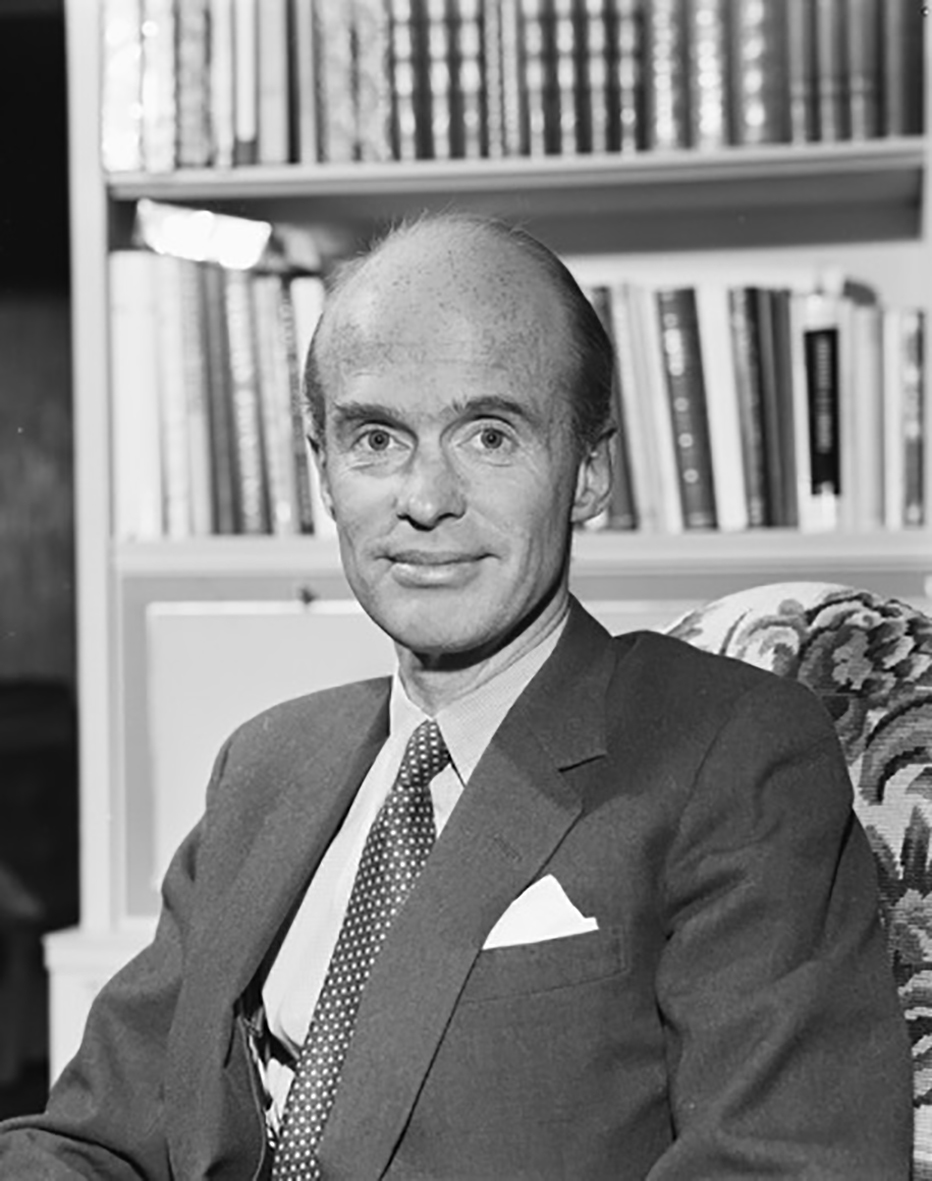 Noco og opprettelsen av Saga
Noco og opprettelsen av SagaThis offer was received too late for negotiations to be resumed. With an eye to the big Ekofisk discovery made by Phillips, Olsen has subsequently commented: “It was a great pity. That’s how you can get it wrong.”[REMOVE]Fotnote: Fred Olsen in an interview with Sigvart Østrem, NRK, 8 June 2009. But Olsen and the Noco partners nevertheless had no reason to be dissatisfied.
As decided at the 9 April meeting, a partnership agreement was entered into with Amoco, and the well which discovered Valhall was spudded on 7 April 1975 – almost exactly 10 years later.
AmocoNoco group seeks licences